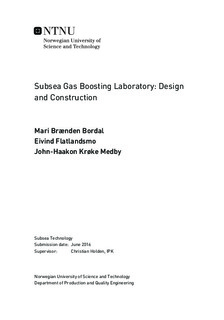| dc.description.abstract | Enhanced oil recovery has been a major focus area for the oil and gas industry over the past years. The need for more and better recovery methods has increased as many of the major oil and gas fields are entering the last phases of their lifetime. Subsea boosting technology was introduced as a result of this. The most common boosting methods are subsea multiphase pumping for transport over longer distances and water injection for increased reservoir pressure.
The latest development in subsea boosting is subsea gas compression. In this project the different existing subsea gas compression solutions are presented.
To investigate issues connected to gas boosting, the Department of Production and Quality Engineering at NTNU wanted to construct a laboratory.
The goal of this master project was to design and construct this laboratory, at a cost of approximately 150.000~NOK.
The lab objectives include control of the flow in the system, mapping of the compressor characteristics, using the lab as a pre-testing facility before full-scale testing at the Department of Energy and Process Engineering, and using it for educational purposes.
The main components of the lab are a turbocharger, a piston compressor, a separator, a cooler and flow control valves.
It is possible to run three different scenarios to emulate the different existing wet gas compression solutions. The first is wet gas compression with separation where the gas and liquid are boosted separately before being rejoined in a multiphase pipeline. The second scenario is wet gas compression without separation. The separator is bypassed and the two-phase flow is compressed in the wet gas compressor. The last scenario is dry gas compression.
The final design of the lab was highly influenced by HSE. Risk analysis were conducted to find the most critical components in view of both personnel and system safety. In order to lower the risk for damage to personnel, safety measures were made that changed the physical layout of the lab.
Many of the system components had to be handmade by the student group. The main reason for this was to stay within the given budget of the lab. One example is the construction of the separator where the total cost ended at approximately 70~\% less than the offer made by a potential supplier.
The lab is not yet completed. Before experiments can be conducted, software for control and monitoring of the flow has to be implemented. In addition, the lab location has to be decided to complete the final physical layout. | |

